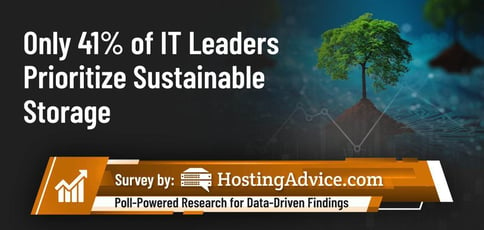
Key Takeaways
- 61% of organizations have placed greater emphasis on sustainability over the past year, though cost and performance still outrank green priorities for 48% of IT leaders.
- While 85% of those surveyed say they're willing to pay more for sustainable data storage solutions, only 41% actually make sustainability a top priority in their decision-making process.
Sustainability may dominate boardroom presentations, but when it comes to making decisions about data storage infrastructure, most IT leaders are still prioritizing cost and performance. That’s one of the key findings from HostingAdvice’s latest survey.
We polled 500 U.S.-based IT leaders at companies with at least 50 employees to get a pulse check on how green priorities are shaping the market for data storage and web hosting.
Sustainability Conversations Are Happening Among 90% of IT Leaders
Nearly 9 out of 10 IT leaders say sustainability comes up in internal discussions. In fact, 43% report that it’s constantly embedded in strategy, while another 47% say it surfaces occasionally — often in board or ESG reporting. Only a sliver of respondents (2%) admit that sustainability is never mentioned inside their organizations.
What’s more, the focus on sustainable practices is trending upward. Over the past year, 61% of respondents say their organization has placed greater emphasis on sustainability. Just 7% say the opposite, that it has slipped. It could perhaps be a reflection of shifting political winds or cost pressures.
Cost and Performance Still Trump Sustainability
Despite this growing awareness, sustainability often gets bumped down the priority list. Nearly half of IT leaders (48%) admit that cost and performance still outweigh sustainability when choosing data storage solutions. Only 41% say being green is a top priority.
And for some (8%), it’s on the radar but rarely factors into real decisions. A small minority (2%) flat out don’t consider it at all.
“When budget season comes around, that well-meaning PowerPoint presentation on sustainability gets pushed to the side by hard calculations about ROI,” says Joe Warnimont, Senior Analyst at HostingAdvice. “CFOs want immediate cost savings, so they’re more likely to trump these corporate ideas about long-term environmental benefits. Unless you can prove both short-term and long-term cost savings from sustainability efforts, most CFOs will keep kicking the can down the road.”
It’s also a story of extremes across industries. In telecom, where energy use and data growth are front and center, more than three-quarters (76.5%) of IT leaders rank sustainability first. Meanwhile, in government and the public sector, only 6.7% say the same.
This could be due to a combination of things: legacy systems, budget constraints, the current administration’s viewset, etc.
The ‘Intention-Action Gap’
What I found most interesting in our survey results is a contradiction in the respondents’ answers. There’s a gulf between what IT leaders say they want and what they actually do.

A whopping 85% say they would pay more for a sustainable solution — provided performance remains equal — either outright (22%) or if longer-term costs come down (63%). Yet only 41% actually put sustainability as a core priority when choosing infrastructure. That’s a striking 44-point “intention-action gap” that exposes the difficulty of turning green commitments into business realities.
Company Size vs. Industry: What Drives Green Priorities?
One of the more subtle findings in the data: company size plays less of a role in shaping sustainability attitudes than industry does. While large organizations often have the resources to run comprehensive ESG programs, smaller firms (101-500 employees) actually show 9.5 percentage points lower sustainability engagement, on average, likely due to a combination of agility and founder-driven focus.
Ultimately, though, the difference in attitudes is more pronounced when looking across sectors. Telecom and tech companies tend to lead in sustainability, while public sector organizations lag.
Why It Matters for Web Hosts and Data Centers
For web hosting companies and storage vendors, this gap presents both a challenge and an opportunity. Nearly 9 out of 10 potential customers said they are open to paying a premium for sustainable offerings, if those solutions are packaged and positioned correctly.
The market is there. The messaging just needs to bridge the divide between sustainability as a talking point and sustainability as a buying criterion.
One thing’s clear: sustainability isn’t going away. If anything, it’s becoming harder for IT teams to ignore. The fact that 61% of IT leaders say their organizations are placing more emphasis on it shows the momentum is building. But there’s still a gap between what gets talked about in strategy meetings and what drives purchase decisions on the ground.

For web hosts and data storage providers, this is a real chance to stand out as IT leaders are willing to pay more for a greener solution. But vague promises and buzzwords won’t cut it.
Providers need to make the case with numbers, outcomes, and a clear value story that resonates with both the finance team and the sustainability champions inside organizations. In other words: make it real and make it worth it, and you’ll have buyers ready to listen.
Methodology
This survey was conducted online in May 2025 among 500 senior U.S.-based IT employees. These respondents are employed at the Senior Manager level or higher. Approximately 41% of respondents are C-level, Vice Presidents, or Directors.
Respondents were selected from a third-party research panel. The researcher ensures high-quality data through multiple layers of protection. It monitors each respondent with a fraud score based on in-survey behavior, inconsistent demographics, and survey speeding — removing anyone who exceeds its threshold. Invisible reCAPTCHA blocks bots, and all data is encrypted with TLS to keep responses secure.
To protect the privacy of panelists, there is never any personally identifiable profile data reported. The overall margin of error is ±4 percentage points at the 95% confidence level. Margins of error increase for subgroups such as age or gender.
For media inquiries, please reach out to adam.blacker@hostingadvice.com.










